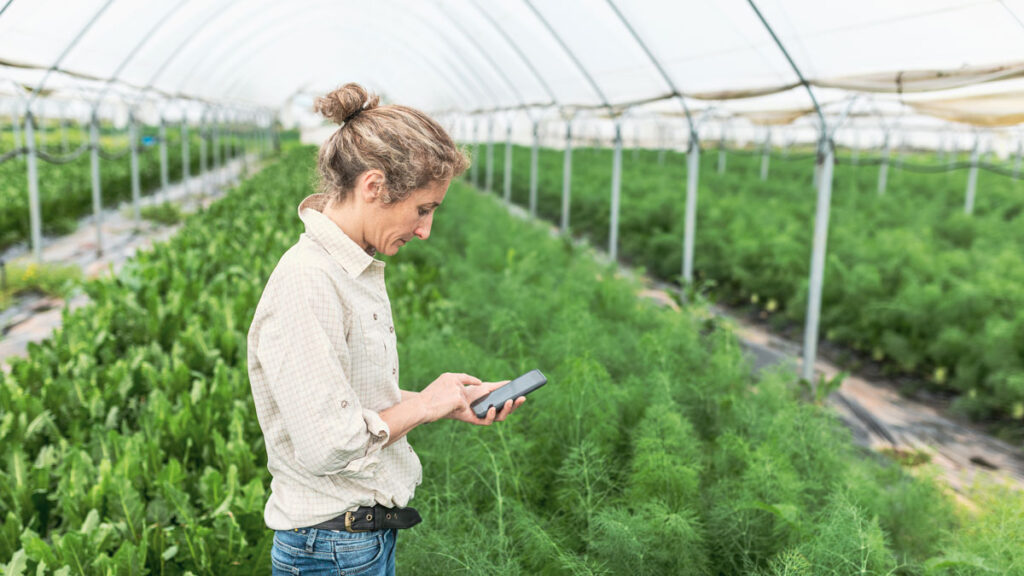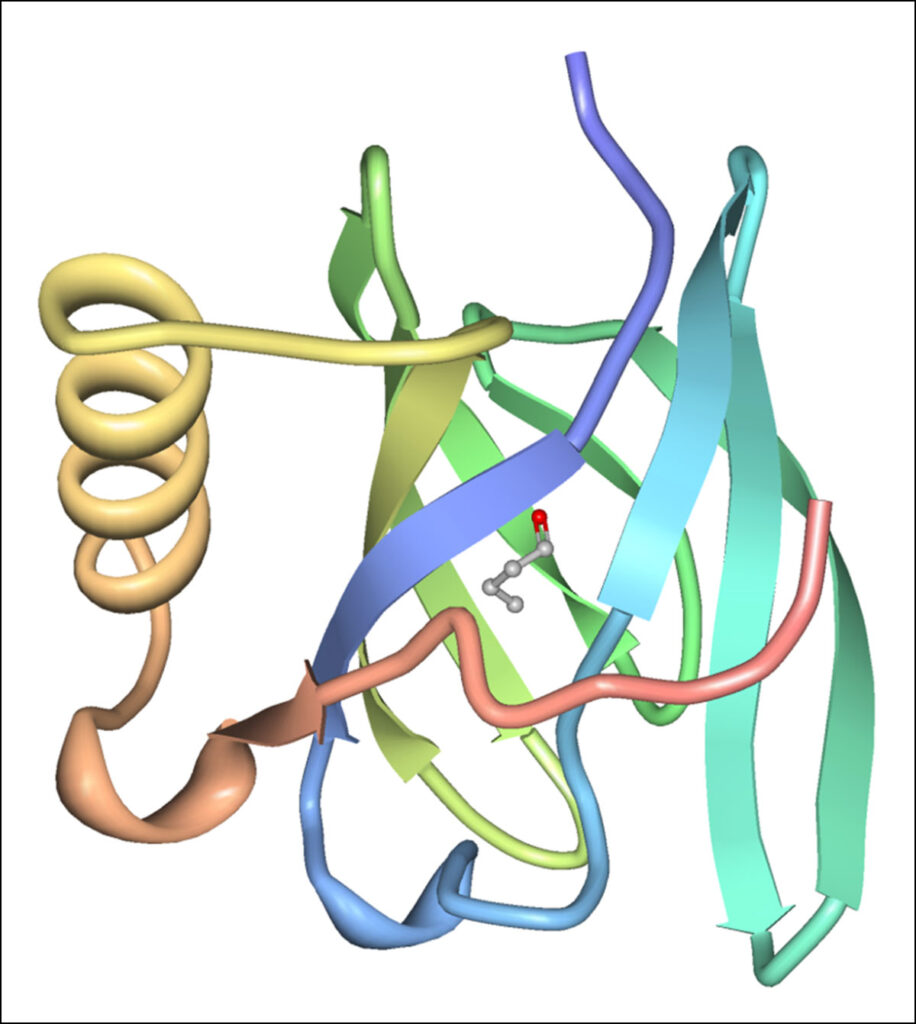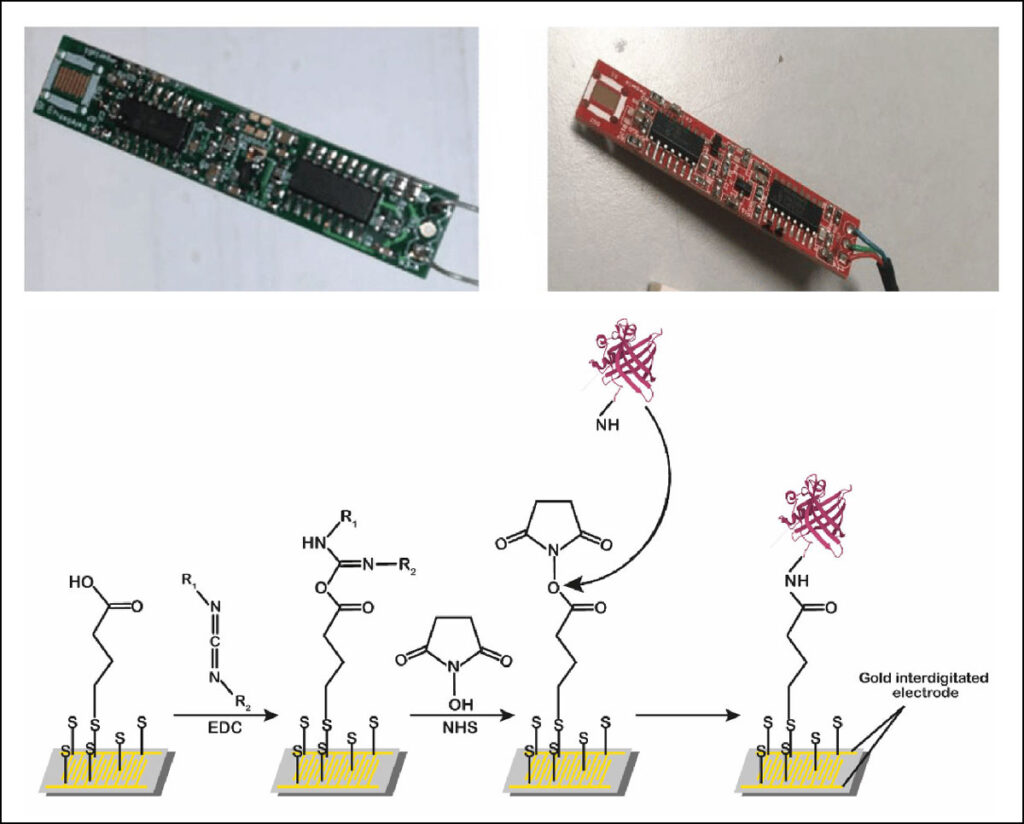

Imagine a farmer standing in her field—or even sitting at home—when she gets an alert from a handheld device: Her crops are showing signs of stress, not from heat, drought, or lack of nutrients in this case, but from a pesticide spill detected upstream. The alert doesn’t come from a lab test conducted days after the initial contamination. Instead, it is generated in real time by a portable biosensor containing a protein derived from a pig’s nose.
Chemical-sniffing sensors, though not yet widely adopted in agriculture or environmental science, represent an emerging field of research and development.
The protein has been reprogrammed to mimic the molecular recognition capabilities of animal olfaction, allowing it to detect specific volatile chemicals associated with pesticide contamination and enabling rapid on-site detection. With this early warning, the farmer can act swiftly to mitigate negative impacts and protect both her crops and future yield.
Chemical-sniffing sensors like this, though not yet widely adopted in agriculture or environmental science, represent an emerging field of research and development. They also offer viable new tools for addressing urgent 21st century environmental challenges related to climate change, rapid industrialization, urban sprawl, deforestation, and agricultural intensification, which threaten biodiversity, food security, and public health globally.
In response to these challenges, the United Nations’ Sustainable Development Goals (SDGs)—particularly SDG 6 (Clean Water and Sanitation), SDG 12 (Responsible Consumption and Production), SDG 13 (Climate Action), SDG 14 (Life Below Water), and SDG 15 (Life on Land)—call for integrated, data-driven approaches to environmental monitoring and management that support environmentally, economically, and socially responsible practices.
Implementing these goals, especially in remote regions and developing nations, requires affordable, scalable methods for monitoring air, water, and soil resources that deliver timely and actionable information. Naturally occurring animal proteins, paired with biosensing technology, offer a promising foundation.
A Transformative New Approach
Detecting pollutants in air, water, or soil often requires sending samples to distant laboratories for gas chromatography, mass spectrometry, or other high-precision analyses. These tools are indispensable for regulatory science because they deliver highly accurate, standardized measurements of trace contaminants that can withstand legal and policy scrutiny. However, the time required to collect, ship, and analyze samples delays results and limits their usefulness for rapid, local decisionmaking.
Conventional in situ monitoring systems, such as stationary air- and water-quality stations, provide continuous data but are expensive to install and maintain. As a result, they are typically sparsely distributed, provide limited spatial coverage, and require significant power, connectivity, and upkeep. Together the high costs and infrastructure demands of current methods make them impractical for widespread field deployment, especially in remote, resource-limited, or rapidly changing environments.
Biosensors present a viable, transformative alternative. Compact, energy-efficient, and often portable, these devices combine biological recognition elements, such as enzymes, antibodies, or odorant-binding proteins (OBPs), with signal transducers to detect specific compounds on-site, in real time, and at low cost. Notably, these devices can sense volatile chemicals and bioavailable pollutant fractions, making them well-suited to complement or even replace traditional environmental monitoring tools in certain settings.

OBPs, a class of tiny but mighty proteins found in the olfactory systems of insects and vertebrates, are especially appealing options (Figure 1). They detect trace amounts of odorants—the molecules behind scents—in complex, chemically noisy environments. Whether it is a moth navigating miles to find a mate, or a mammal sniffing out food, OBPs enable detection of a few key molecules amid thousands.
Today researchers are repurposing OBPs to sniff out the chemical by-products of modern life. These proteins possess high thermal and chemical stability, are easy to synthesize, and are remarkably versatile. They can be integrated into portable devices and miniaturized sensors, affixed to biodegradable materials, and genetically engineered to target specific chemicals in soil, air, or water.
OBPs in Action
Despite their promise, biosensors remain underrepresented in discourse and planning related to environmental monitoring and sustainability. More often than not, prototypes developed and tested in the laboratories fail to reach broad application in the field. Specific uses of OBPs have remained largely siloed within biomedical and entomological research.
However, emerging applications of OBPs align closely with key geoscience priorities, including tracking pesticide and industrial runoff, monitoring volatile compounds and mapping soil emissions, and identifying plant health indicators tied to environmental stress and drought. Several proof-of-concept and real-world demonstrations are already underway, highlighting how OBPs can detect a range of pollutants across different environments.

Porcine OBPs have been engineered to detect BTEX pollutants (benzene, toluene, ethylbenzene, and xylene) originating from pesticides and petroleum runoff that threaten groundwater and soil health (Figure 2) [Capo et al., 2022, 2018]. Bovine OBPs, immobilized on cartridge-like devices, can selectively bind and remove triazine herbicides from water, demonstrating potential for both detection and remediation of the pollutant in water treatment [Bianchi et al., 2013].
Sensors coated with bovine and porcine OBPs detect trace, mold-related volatile organic compounds (VOCs) such as octenol and carvone [Di Pietrantonio et al., 2015, 2013], which is relevant to both indoor and outdoor air quality monitoring and mitigation of post-harvest crop losses. Low-cost, OBP-functionalized devices have also demonstrated selective detection of butanal, a common VOC linked to industrial and urban particulate matter [Cennamo et al., 2015].
In addition to bovine and porcine OBPs, rat OBP derivatives have been customized and immobilized on sensing platforms to enable simultaneous VOC profiling for air and water pollution diagnostics [Hurot et al., 2019]. Furthermore, insect OBPs, embedded in fluorescence-based biosensors, have shown efficacy for detecting bacterial metabolite, offering a possible approach for rapid coliform bacteria screening in drinking water [Dimitratos et al., 2019].
Beyond environmental and water quality applications, OBPs from multiple species have also been used to monitor for plant-emitted VOCs that signal stress, disease, drought, or pest infestation in agricultural systems [Wilson, 2013], providing valuable insights into crop health and enabling early intervention strategies.
The Potential Is Enormous
Integrating OBPs into environmental monitoring systems opens new frontiers in climate-smart agriculture, distributed sensing networks, and adaptive land use management.
Integrating OBPs into environmental monitoring systems opens new frontiers in climate-smart agriculture, distributed sensing networks, and adaptive land use management. These sensors offer lab-grade sensing of emissions from sources such as livestock waste, fertilizer application, and wetland activity. They may also enable real-time monitoring of greenhouse gas precursors and early detection of soil degradation, microbial shifts, or drought stress—all delivered through devices small enough to fit in your pocket.
Early detection of pollutant leaks or VOC hot spots could inform land use strategies that mitigate volatile emissions, improve air quality, and strengthen climate adaptation. OBP sensors’ low power requirements and biodegradability make them ideal for decentralized deployments, especially in low-resource or remote areas. Engineered differently, these proteins could even serve in preventative technologies as molecular sponges or scavengers that capture and bind VOCs before they accumulate or disperse.
Ultimately, OBPs could enable more data-driven decisions in conservation and climate policy, while offering novel tools for mapping environmental dynamics (e.g., tracking the spread of wildfire smoke plumes, monitoring methane emissions, or detecting waterborne coliforms across river networks) at finer spatial and temporal resolutions than current technologies permit.
From the Bench to the Biosphere
We envision a future in which OBPs are central to smart agriculture platforms, mobile environmental sensing labs, and biodegradable field-deployable kits. The underlying technology is sound, but breakthroughs like this don’t happen in isolation. Cross-disciplinary collaboration is crucial to accelerate and scale this development, reduce risks of field deployments, and ensure that innovations are aligned with real-world policy and practice.
We propose several pathways to support this collaboration and innovation. For example, targeted workshops and research consortia could facilitate dialogue among molecular biologists, environmental engineers, and Earth scientists to identify priority research questions and focus efforts on specific environmental challenges.
Key questions for advancing OBP-based sensing include the following: Which pollutants and ecosystem signals are most critical for understanding today’s environmental challenges? How can OBPs be tuned to target specific compounds under varying soil, air, or water conditions? What substrates can effectively host OBPs for real-world sensing without compromising environmental safety?
As part of this dialogue, environmental scientists could contribute by generating regional maps of priority VOCs linked to specific issues such as crop stress, emissions from peatlands, or urban air pollutants, guiding optimization of OBP-based sensors. Similarly, chemists and bioengineers could collaborate to expand the library of OBPs with tailored affinities for emerging pollutants, such as pharmaceutical residues, industrial solvents, or novel agrochemicals, broadening the range of compounds detectable in real-world settings. In parallel, data scientists and systems engineers could develop machine learning models to decode complex VOC signatures captured by OBP sensors, enabling real-time diagnostics, pattern recognition, and predictive analytics across environmental monitoring networks.
Expanding access to knowledge and resources represents another key pathway for advancing OBP-based sensing.
Expanding access to knowledge and resources represents another key pathway for advancing OBP-based sensing. Developing curated, open-source, and searchable repositories of OBPs from diverse organisms with characterized binding affinities for high-priority VOCs would accelerate biosensor design and prototyping. Such repositories should follow FAIR (Findable, Accessible, Interoperable, Reusable) data principles to maximize their usefulness across disciplines and platforms.
In the United States, agencies such as the National Science Foundation, the Department of Agriculture, EPA, and the Department of Energy could accelerate progress by hosting seed funding workshops to define shared goals, barriers, and applications and by providing joint funding for interdisciplinary biosensing projects.
Establishing and sharing experimental field test beds such as smart farms, urban air zones, and wetlands would enable pilot testing of OBP-based sensors alongside conventional instruments. These biosensors could be integrated into existing monitoring networks like the National Ecological Observatory Network and the Long Term Ecological Research Network. Their outputs could feed into land use, emissions, and ecological models to improve the spatiotemporal resolution of environmental data.
Building on these test beds and integrated networks, collaborating researchers could report cross-disciplinary benchmark studies and coauthor seminal papers detailing protocols, use cases, and best practices for OBP-based biosensing. This coordinated effort would guide future research and help establish the field’s credibility with regulators and funding agencies.
Clearing Barriers on the Road Ahead
For all of the upsides of OBP-based biosensing, several technical and logistical issues must be addressed before their widespread deployment is achieved.
Despite their superior stability compared to enzymes or typical antibodies [Dimitratos et al., 2019], OBPs remain susceptible to denaturation or degradation during prolonged environmental exposure. Environmental conditions such as humidity, pH, and salinity can affect their performance, underscoring the need for robust protocols to stabilize and calibrate these proteins across diverse ecosystems.
Advancing real-time data acquisition and remote monitoring with OBP-based biosensing also requires progress toward integrating the proteins with digital platforms in scalable and reproducible formats. Key challenges include reducing sensor-to-sensor variability, increasing sensor lifespans, and converting biological signals into stable, digitized outputs.
Realizing the technology’s broader potential will require rigorous technical validation, clear regulatory guidance, and proactive efforts to educate and engage stakeholders.
In addition to technical barriers, regulatory frameworks and approval pathways for OBP-based sensing technology remain underdeveloped, and concerns about the lack of standardized validation protocols and the effects of releasing recombinant proteins into agricultural or environmental settings persist. Moreover, low awareness among end users, including farmers and land managers, may hinder trust and uptake of the technology. Realizing its broader potential will thus require rigorous technical validation, clear regulatory guidance, and proactive efforts to educate and engage stakeholders across sectors. Notwithstanding these challenges, the promise is clear: OBPs offer a flexible and powerful approach for monitoring environmental changes and climate risk, helping to protect ecosystems, food systems, and communities. Once known primarily to entomologists, these little scent-sniffing proteins could become an unexpectedly powerful tool for advancing environmental resilience.
References
Bianchi, F., et al. (2013), An innovative bovine odorant binding protein-based filtering cartridge for the removal of triazine herbicides from water, Anal. Bioanal. Chem., 405, 1,067–1,075, https://doi.org/10.1007/s00216-012-6499-0.
Capo, A., et al. (2018), The porcine odorant-binding protein as molecular probe for benzene detection, PLOS One, 13(9), e0202630, https://doi.org/10.1371/journal.pone.0202630.
Capo, A., et al. (2022), The porcine odorant-binding protein as a probe for an impedenziometric-based detection of benzene in the environment, Int. J. Mol. Sci., 23(7), 4039, https://doi.org/10.3390/ijms23074039.
Cennamo, N., et al. (2015), Easy to use plastic optical fiber–based biosensor for detection of butanal, PLOS One, 10(3), e0116770, https://doi.org/10.1371/journal.pone.0116770.
Dimitratos, S. D., et al. (2019), Biosensors to monitor water quality utilizing insect odorant-binding proteins as detector elements, Biosensors, 9(2), 62, https://doi.org/10.3390/bios9020062.
Di Pietrantonio, F., et al. (2013), Detection of odorant molecules via surface acoustic wave biosensor array based on odorant-binding proteins, Biosensors Bioelectron., 41, 328–334, https://doi.org/10.1016/j.bios.2012.08.046.
Di Pietrantonio, F., et al. (2015), A surface acoustic wave bio-electronic nose for detection of volatile odorant molecules, Biosensors Bioelectron., 67, 516–523, https://doi.org/10.1016/j.bios.2014.09.027.
Hurot, C., et al. (2019), Highly sensitive olfactory biosensors for the detection of volatile organic compounds by surface plasmon resonance imaging, Biosensors Bioelectron., 123, 230–236, https://doi.org/10.1016/j.bios.2018.08.072.
Wilson, A. D. (2013), Diverse applications of electronic-nose technologies in agriculture and forestry, Sensors, 13(2), 2,295–2,348, https://doi.org/10.3390/s130202295.
Author Information
Ishani Ray (isray@okstate.edu) and Smita Mohanty, Department of Chemistry, Oklahoma State University, Stillwater
Citation: Ray, I., and S. Mohanty (2025), Protein-powered biosensors with a nose for environmental ills, Eos, 106, https://doi.org/10.1029/2025EO250330. Published on 8 September 2025.
This article does not represent the opinion of AGU, Eos, or any of its affiliates. It is solely the opinion of the author(s).
Text © 2025. The authors. CC BY-NC-ND 3.0
Except where otherwise noted, images are subject to copyright. Any reuse without express permission from the copyright owner is prohibited.


